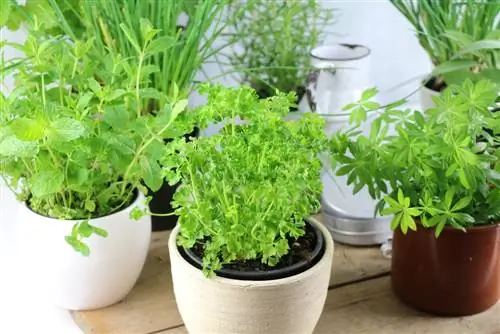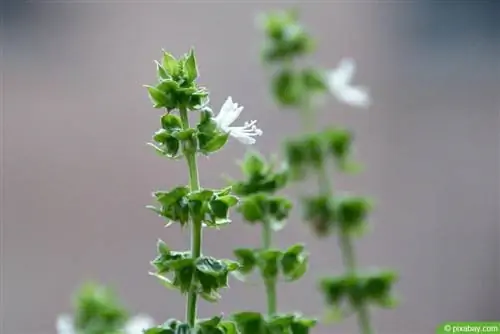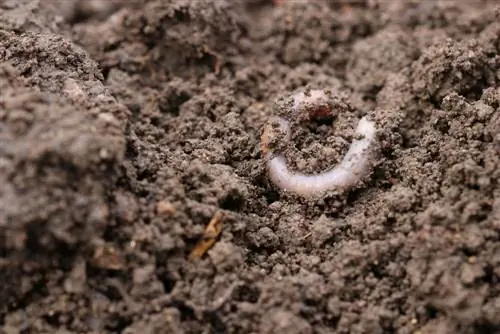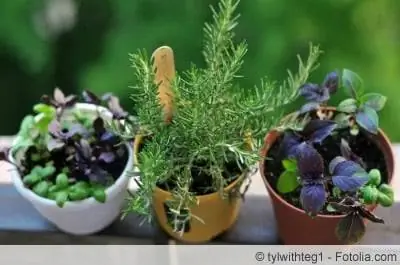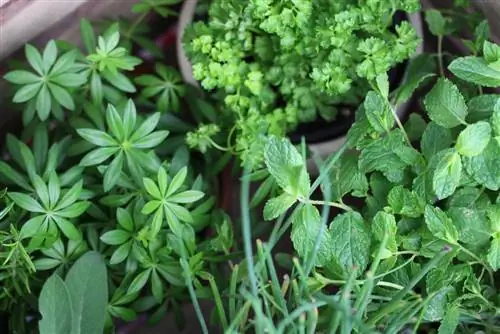- Author admin [email protected].
- Public 2023-12-17 03:39.
- Last modified 2025-06-01 06:48.
Is the herb garden celebrating its premiere in your green kingdom? Then you have made exactly the right decision to season your dishes with dewy oregano, dill, basil or thyme in the future. Since herbs thrive just as well in the bed as they do in the pot on the balcony, the plan works even without your own garden. What matters are factors such as the right time and the suitable substrate. Since not all herbs harmonize with each other, the question of which ones go together is also answered below.
The right time
The vast majority of herb plants are hardy. When choosing the best date for planting, the importance of delayed ground frosts should be taken into account. The young plants that have been grown by hand or purchased ready-made are therefore not planted in the bed or pot until the end of April/beginning of May at the earliest. Until after the sheep's cold, the sensitive varieties or the entire bed are covered with fleece overnight.
Suitable substrate
There is no such thing as a non-plus-ultra substrate for herbs. Rather, the precise composition depends on the very different requirements. Mediterranean herbs such as lavender, basil or oregano thrive particularly well in sandy, dry soil, while tarragon prefers to extend its roots in fresh, moist substrate. However, the fact that they develop a much more intense aroma in poor soil applies equally to all species. It follows that commercially available, pre-fertilized potting soil is unsuitable in the pot because the plants sprout without any sense or purpose. The following potting soils meet the basic requirements of all herbs:
- In the bucket a mix of clay, sand and compost in equal parts
- Alternatively, special organic herbal soil from specialist retailers
- In the bed, humus-rich, well-drained garden soil with normal nutrient content
- Matched to the type of herb, enriched with sand, limestone gravel, compost or horn shavings
Mineral-chemical additives have no place in the flawless substrate for culinary herbs. Even if the plants are planted on a bed that has been fallow for a long time, organic soil additives can be used to improve the soil he althily, such as compost, algae lime or primary rock powder.
Tip:
So that the positive characteristics of the substrate fully develop their potential, the location should be as sunny as possible. Ideally, a hedge serves as a bed border to protect against strong winds.
Planting herbs - step-by-step instructions
If the desired date in the calendar has been reached and young plants and working materials are available, the planting process does not turn out to be complicated. It is an advantage if there is a plan to provide guidance regarding the specific arrangement. The bed is divided into segments, which are processed according to the specific location requirements of individual herb plants. Here's how to do it:
- Put the still potted herbs in water until no more air bubbles appear
- Weed the bed soil, loosen it thoroughly and clean it of roots or stones
- Incorporate soil additives as required
- Dig planting holes with appropriate spacing
- Insert the potted plants, surround them with soil, press down and water
In the bucket or flower box, first place a 2-3 centimeter high layer of gravel, perlite or pottery shards over the water drain. This drainage reliably prevents waterlogging.
Herbal solitaires
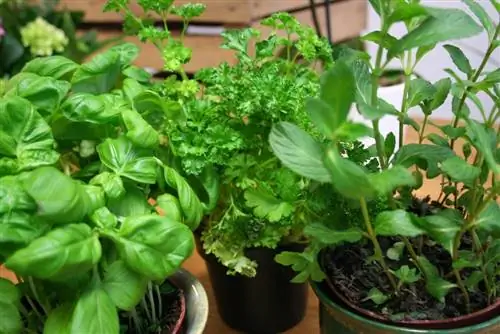
The following large specimens should generally be planted in a solitary position because no other plant neighbors will thrive next to them. These include angelica, lovage, lemongrass, common laurel and wormwood. These herbs are given their own pot in the herb garden on the balcony. A planting distance of at least 60-80 centimeters is recommended in the bed.
These herbs go together
In order to make an informed decision about which herbs get along well with each other, various criteria must be taken into account. The central rule of thumb has proven to be that annual and perennial herbs do not mix well. Conversely, this means that each of the two categories prefers to keep to themselves. The reason for this is that long-lived herb plants do not want to have a new neighbor every year. The short-lived species and varieties, on the other hand, favor an annual change of location. However, there are a number of exceptions to this rule.
Annual herbs
Popular annual herbs include dill, chamomile, marjoram, parsley, rosemary, borage or nasturtium. The most sociable representative of this class is basil, because there is hardly a plant that is not compatible. In addition, basil effectively protects its plant neighbors against pests and fungal diseases. Ideal combinations among annual herb plants are:
- Basil and rosemary
- Dill, cress, marjoram, parsley, chervil
- Chives, chamomile
Perennial Herbs
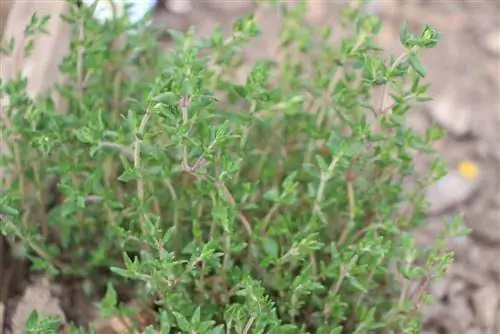
The popular perennial herbs include, in addition to thyme and oregano, well-known representatives such as sage, chives, fennel, lemon balm, tarragon or caraway. Lemon balm is considered just as easy to use in this category as basil in the annual range. However, the two of them don't get along.
These neighbors support each other particularly intensively:
- Sage, chives, tarragon, thyme
- Savory, oregano, sage
- Thyme, fennel, tarragon, savory
- Chives, dill, savory, chamomile
Good neighborhood in a semi-shady location
If the lighting conditions at the location are another criterion, the planting plan for the bed should combine herbal plants that do not rely on permanent sunshine. These include watercress, dill, parsley, fennel, tarragon, chives, peppermint and chamomile.
The partially shaded conditions are naturally accompanied by a humus-rich, nutrient-rich and slightly moist soil. Less light and dry rock garden soil do not allow herbs to thrive.
Best tolerance in sunny locations
If you locate your herb garden in full sun, focus on Mediterranean, drought-loving species and varieties. Species such as savory, rosemary, basil, lavender, oregano, sage and thyme feel at home here.
Why should herbs go together?
It undoubtedly takes a little effort to combine the herbs in the bed and planter in the right way. However, it is not a Sisyphean task because you benefit from a number of advantages. If the herbs fit together, the root exudates complement each other. This leads to them protecting each other from disease. If a plant attracts beneficial insects, they destroy the neighboring pests. In addition, the sensible mixed culture helps protect against soil fatigue. However, if you plant herbs in a close community that are not fond of each other, they will inhibit each other's growth. In the worst case scenario, one plant takes over the dominant role and suppresses its neighbor. For example, if thyme and marjoram end up next to each other, the latter usually loses out and you won't have fresh marjoram in the kitchen.
Conclusion
Having your own herb garden is trendy because it has convincing advantages. Planted in the bed or on the balcony, fresh herbs are available for the kitchen all year round. However, the most loving care will not result in the desired lush harvest if the plants do not harmonize with each other. In addition to choosing the right time for planting and the appropriate substrate, the herbs should fit together. The rule of thumb that annual and perennial varieties struggle in a close community shows the way, but is not fundamentally valid. It's worth investing time in creating a planting plan that takes all criteria into account.

